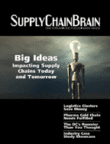
Home » Is There a Talent Generation Gap in U.S. Distribution?
Is There a Talent Generation Gap in U.S. Distribution?

October 8, 2012
Panalpina is a Swiss company that provides forwarding and logistics services, specializing in intercontinental air and ocean freight and associated supply chain management solutions. Panalpina management reportedly operates a network of 500 branches in more than 90 countries on six continents; in 60 other countries, the group cooperates closely with selected partners. Panalpina employs some 15,000 people worldwide.
Regardless of their vertical, most companies that have been around for some time, are dealing with - or will soon face - the loss of knowledge capital due to the retirement of the Baby Boomer generation. Panalpina is no different. In a conversation at the annual conference of the Warehousing Education and Resource Council, held this year in Atlanta, Tim Hotze sat down with SupplyChainBrain to talk about the skills that new entrants bring to the workforce.
Q: You suggest that the talent generation gap, as you call it, is one of the hottest issues your company is trying to solve today. Do I understand that correctly?
A: Hotze: Yes. What I see in the U.S. market and in distribution is that it's tough to find local leaders who are in engineering distribution operations and take them to next level, using analytics and a more number-driven approach to optimizing processes and also thinking outside of the box to drive innovation within a four-wall operation.
Q: So you're saying that younger people aren't particularly interested in the distribution field as a career?
A: Hotze: What we see specifically in my field of expertise is that a lot of young, talented engineers, industrial engineers, are coming into the marketplace, but it's tough to attract them into traditional distribution operations.
Q: Why?
A: Hotze: They are looking more at consulting or what are probably higher-paying jobs as their entry-level job. Many of them really like project work, and not so much something that's distribution-related.
Q: Let's turn to social media and how that "of-the-moment" phenomenon is working in the traditional warehousing and distribution environment. What are you seeing there?
A: Hotze: Social media can be split into two parts. There is social media for personal use, to get out your brand, your personal brand, your leadership brand or brand name, so to speak. Think about Facebook as more for your personal use. And younger professionals like to use LinkedIn to get their message out.
Then there's social media for companies, specifically in retail, which uses these channels to get their brand image and message out.
There's also social media - I'm not speaking so much of web sites - but of the use of certain technologies as a part of distribution operations. Consider iPads, for instance, where you take pictures and post them during the receipt process. So there are more and more app-driven operations in the traditional four-walled distribution facility.
Q: Clearly, you find the younger generation more familiar with social media and these technologies.
A: Hotze: This is how they grew up. It's a typical channel of information exchange for them, where with the older generation it was more a phone call or personal conversation. Now, it's more about posting your status and getting your message out, branding yourself to some extent. The older generation is clearly more interested in a face-to-face conversation rather than a mass communication out into the field.
Q: You are part of the younger generation that we're talking about. What industries compete for your attention or the attention of people like you?
A: Hotze: About eight to 10 years ago, I asked the same question. Today, compared to the traditional distribution and industrial engineering environment, you would probably go over to the industry side. You could pick any industry.
Q: Okay, let's talk about analytics because this is another area that seems to differentiate the younger generation from the older members of the workforce.
A: Hotze: I see highly educated, young professionals with supply chain and logistics degrees because more and more colleges are offering them. Most of these people are very number-driven because operations research or quantitative network engineering is very number-driven. So we see strong skills set among the 25-year-olds, with very good analytical skills.
On the other hand, the generation that's already in the field, they learn it by doing it, to some extent. So, it's good to be very fast with analytics. But you also need to have the experience. You need to blend the operations experience that the older generation has with the numbers approach that the younger set has.
Q: That suggests there is a role for mentorship, some kind of training role for older employees. Is that the case?
A: Hotze: Mentorship is very important. I had the privilege of having a mentor from the older generation. He taught me everything I know today about logistics and distribution engineering and I am very appreciative. With mentorship, a young professional actually gets accustomed to the company culture, which is important.
Q: You sometimes refer to the coming departure of the older generation as the "gray2k" gap.
A: Hotze: Yes, the gray2k gap can become an issue, especially here in the U.S., where lots of companies have workforces in the distribution area in their late '40s an early '50s. They will have to back-fill positions with staff that are retiring or about to retire in 10 years or so.
They have to grow the talent internally so they can avoid having to go out to the market and buy talent at higher prices.
Q: How do you avoid that?
A: Hotze: You groom talent inside that understands the company culture. It is not only a problem here but in Europe. It's a challenge, and I think that's why mentorship is so important. You can have young professionals enter the company at an early age and be groomed to take on leadership positions somewhat later in their career, understanding the vision and mission of the company.
Q: Despite grooming those already there to take on additional duties, there must be other resources for finding talent. Where else are you looking?
A: Hotze: Typical industry shows and a couple of high-end universities have forums for companies to participate in and discuss topics with students and professors, so that's a good way to exchange information. We see this more and more. My company now goes into the field to meet with students and create and foster these relationships because there is a lot of talent out there.
To view video in its entirety, click here
Resource Link:
Panalpina USA
Keywords: supply chain jobs, supply chain management, logistics management, logistics services, logistics & supply chain, warehouse management, supply chain talent retention
RELATED CONTENT
RELATED VIDEOS
KEYWORDS Business Strategy Alignment Global Supply Chain Management HR & Labor Management Logistics logistics & supply chain logistics management Logistics Outsourcing logistics services Supply Chain Analysis & Consulting supply chain jobs Supply Chain Management supply chain talent retention Transportation & Distribution Warehouse Management
Subscribe to our Daily Newsletter!
Timely, incisive articles delivered directly to your inbox.
Popular Stories

2024 Supply Chain Management Resource Guide: There's Only One Way Off a Burning Platform
VIEW THE LATEST ISSUECase Studies
-
Recycled Tagging Fasteners: Small Changes Make a Big Impact
-

Enhancing High-Value Electronics Shipment Security with Tive's Real-Time Tracking
-

Moving Robots Site-to-Site
-
JLL Finds Perfect Warehouse Location, Leading to $15M Grant for Startup
-
Robots Speed Fulfillment to Help Apparel Company Scale for Growth



